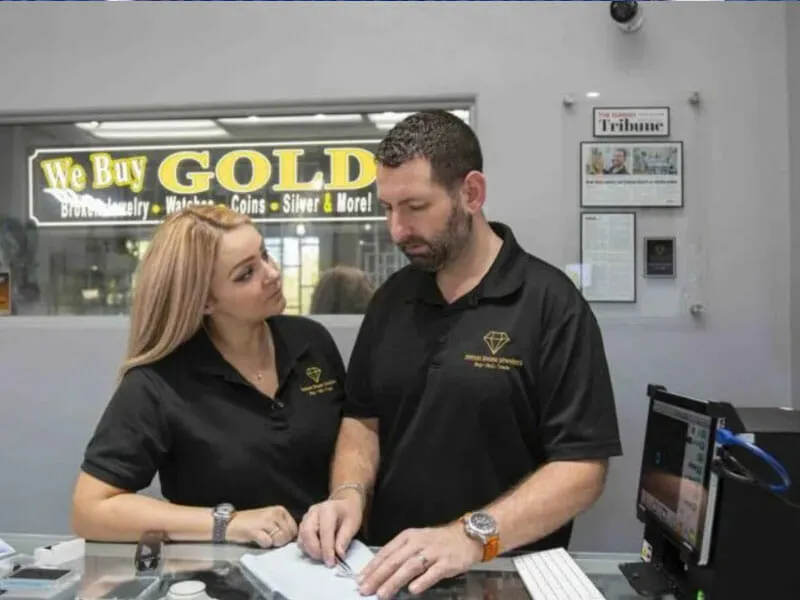
Mesa jeweler warns not all diamonds are your friend
In the last five years, the quality of lab-made diamonds has skyrocketed to the point where they are now commonplace in rings, necklaces and earrings – sometimes unbeknownst to their buyers.
In the name of transparency, a Mesa jeweler is doing his part to ensure his clients know exactly what they are paying for.
David Nelson, who has been in the industry since he was 15, opened Nelson Estate Jewelers with his wife several years ago.
The company is a full-service jewelry store that buys, sells and repairs “valuables” – including estate jewelry.
Now, the store is setting itself apart by using a DiaTrue CS, a machine that detects the origin of almost all types of diamonds.
“It’s the responsibility of an ethical, quality jeweler to make sure their clients are getting what they pay for,” said Nelson.
“I think that it has to be something that is on the forefront of every reputable jeweler’s mind,” he continued.
To use the OGI Systems device, Nelson places a ring setting or parcel of a stone onto a plate that is then inserted into the machine.
The $6,000 device will detect which diamonds are natural and which are not, depending on how the light interacts with the properties of the stone.
“It takes a bunch of pictures and reads how the optical properties work,” said Nelson.
“When dealing with lab-made diamonds, they are grown differently than a natural diamond,” he added. “So, they have different trace elements and it gives a different kind of reading on the machine.”
Nelson said the device can determine the origin of 98 percent of all diamonds that come into his store.
The other two percent are called “Type II,” which have no measurable nitrogen impurities, and have to be referred to a gemological lab, he explained.
Last year, the Federal Trade Commission declared that lab-grown diamonds are in fact real diamonds, but that their value is not equal to their natural counterparts.
All diamonds are priced using a global system created by the International Integrated Reporting Council. Prices are generated first based on the “Four C’s” of diamonds: carat, cut, clarity, and color.
Whether they are lab-grown or mined is then taken into consideration.
Nelson expressed that while he believes the controversy surrounding synthetic diamonds is still in its “infancy stage,” it will become increasingly problematic over time.
His concerns stem from the possibility of shady retailers ripping off their clients.
“Most of the manufacturers are trying to be responsible by putting an indication on the side point of a diamond that says ‘lab-made,’” said Nelson, adding:
“But the problem is that there is not a whole lot stopping someone from removing that inscription and then trying to pass it off as natural.”
“I had a guy in here last week who bought a pair of what was advertised online as lab-manufactured studded earrings,” he continued. “Then I found out they weren’t even diamonds at all with my machine.”
The jeweler added that the synthetic stones have almost “zero second-sale value” and that he believes they will only continue to plummet in worth.
On the flip side, the rarity factor for natural-mined diamonds is on the incline, he said.
“Fine-quality stones will likely continue to increase in rarity because less are coming out of the ground,” he said. “The peak production of diamonds has already come and gone – we are not producing more than we have been in the past.”
A majority of the diamond mines today are located in Russia, South Africa, China, Brazil, Australia and Canada, according to Geology.com.
Another factor that complicates the debate is climate.
Nelson expressed dismay that certain companies are advertising non-natural stones as “greener” solutions for the environment – when that may not necessarily be the case.
The FTC, which investigates allegations of deceptive advertising, sent warning letters to eight lab-grown diamond companies this past spring.
Among its concerns was the use of “eco-friendly” or similar terms to describe diamonds that were made in a laboratory – which uses high temperatures throughout the process.
The commission stated more transparency is needed surrounding how the gases used to extract the carbon are sourced and managed.
While mined diamonds also have a high environmental impact, the carbon intensity is lower, according to an analysis carried out by Trucost for the Diamond Producers Association.
“The thing that drives me insane is that some companies out there are selling these lab-made diamonds and disclosing that they are greener or more ethical,” he said. “The misinformation is out there and it is spreading like wildfire when it may not really be true.”
As far as advice to potential consumers goes, Nelson recommends checking with the jeweler to see if they can confirm their stones’ origins.
“The biggest thing for any consumer, I would say is to ask your jeweler or whoever you’re dealing with, ‘What are you doing to ensure what I am buying is natural?’” he said.
He also advises clients to look for Gemological Institute of America certifications for anything that is over a half carat.




